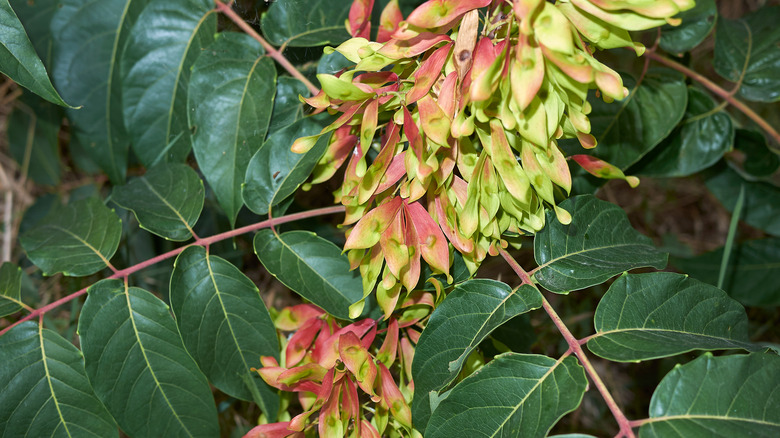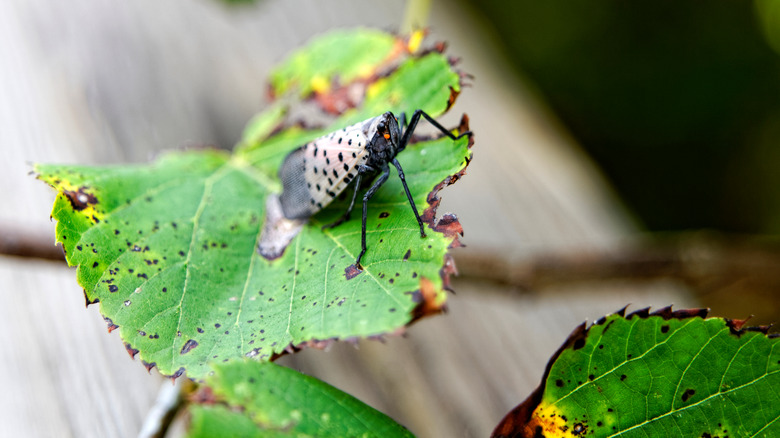This Tree Is A Little-Known Threat To Other Plants In Your Yard
When hearing the name tree of heaven, you may think of a beautiful flowering tree that smells sweet and attracts butterflies. Unfortunately, the real tree of heaven is the exact opposite. It is an invasive species whose leaves release a foul-smelling odor and that is so hard to get rid of that it has been dubbed the "tree of hell." Plus, instead of attracting beautiful butterflies, this tree attracts the spotted lanternfly which is also an invasive species that scientists recommend killing on sight.
Originally brought to the U.S. as an ornamental plant from China in the 1700s, the tree of heaven (also known as Chinese sumac, stinking sumac, and varnish tree) was originally popular because of its hardiness and ability to grow just about anywhere — even in soil with little water or nutrients. However, it is these exact qualities that make the plant dangerous to your yard today. In fact, according to the USDA, the tree of heaven's quick growing time (10 to 15 feet in a year) and extremely successful reproduction allow it to out-grow and out-compete most other plants. However, the dangers of the tree of heaven don't stop there.
Unexpected ways the tree of heaven can harm your yard
Besides just crowding out the other plants in your yard and garden, the tree of heaven can also damage your yard by releasing toxins. In fact, the tree of heaven is known to contain allelopathic chemicals in its bark, roots, and leaves which are released to damage and kill surrounding plants.
On top of this, the tree of heaven can further damage other plants in your yard that aren't even near the tree by attracting spotted lanternflies. While lanternflies don't directly harm humans or animals, they suck sap from trees and plants which can kill certain plants and cause stress to others. Furthermore, the leaking sap increases the likelihood of your plants turning black and sickly due to a fungal disease called sooty mold.
And if that isn't enough, the roots of these invasive trees can damage your home. Trees of heaven, besides releasing tons of seeds to make new sprouts, can spread by producing suckers up to 50 feet away from the original plant. These suckers are a symptom of a large and extensive underground root system which can damage the foundation of your home, crack sewer pipes, and even damage pavement.
How to get rid of a tree of heaven in your yard
The good news about tree of heaven is that it is possible to get rid of it. However, the problem is that killing this plant requires lots of patience and may feel like a multi-year battle with a mythological Hydra — where every time you kill a sprout, two more come up in its place. However, those who persevere will be rewarded. As one Redditor who successfully eradicated the plant from their yard put it, "Removing [trees of heaven] and all their offspring and shoots is a battle of attrition. You have to go all in, but it can be won!"
According to the USDA, the best method to kill this plant is to cut any trees and sprouts as close to the root as possible and then apply herbicide to the cut area within five minutes. If you wait longer than five minutes, it is possible that the tree will have already sealed off the open area preventing the herbicide from effectively damaging the plant.
With small sprouts, the recommended method is to pull them by hand. However, it is important to get all the roots when pulling otherwise the tree will simply regrow. To do this, try pulling sprouts when the soil is soft after rain, or use a shovel to dig out the entire root. Also, the best time to do the most damage to the tree is in the early summer while the root system is still weak and vulnerable.


